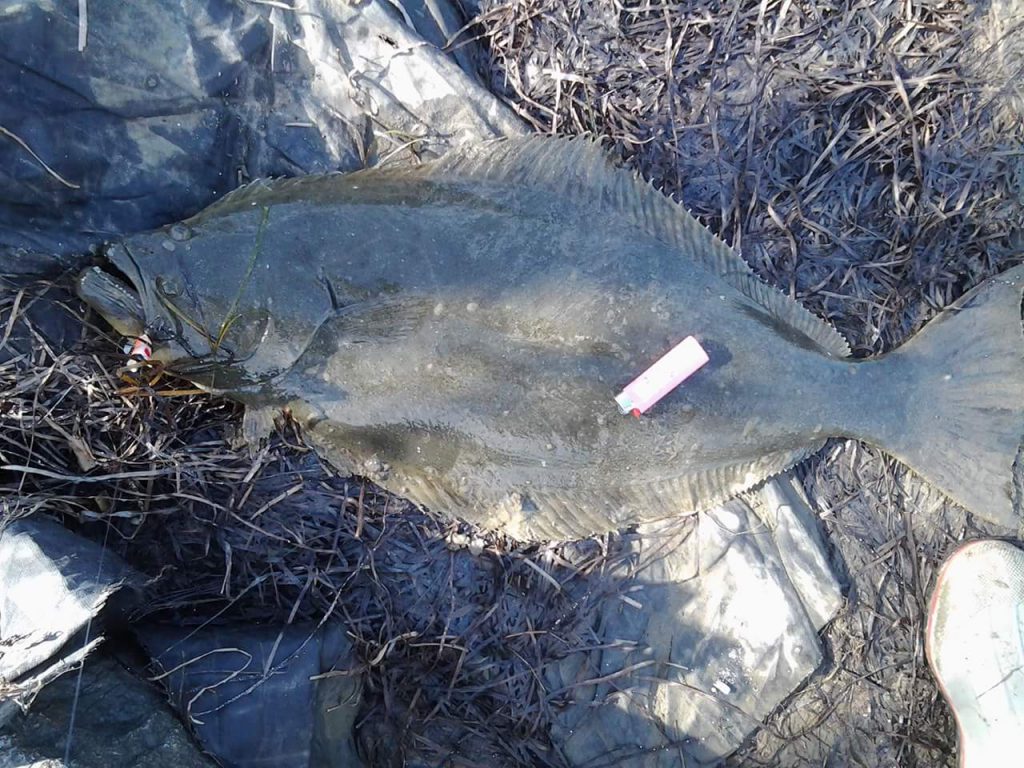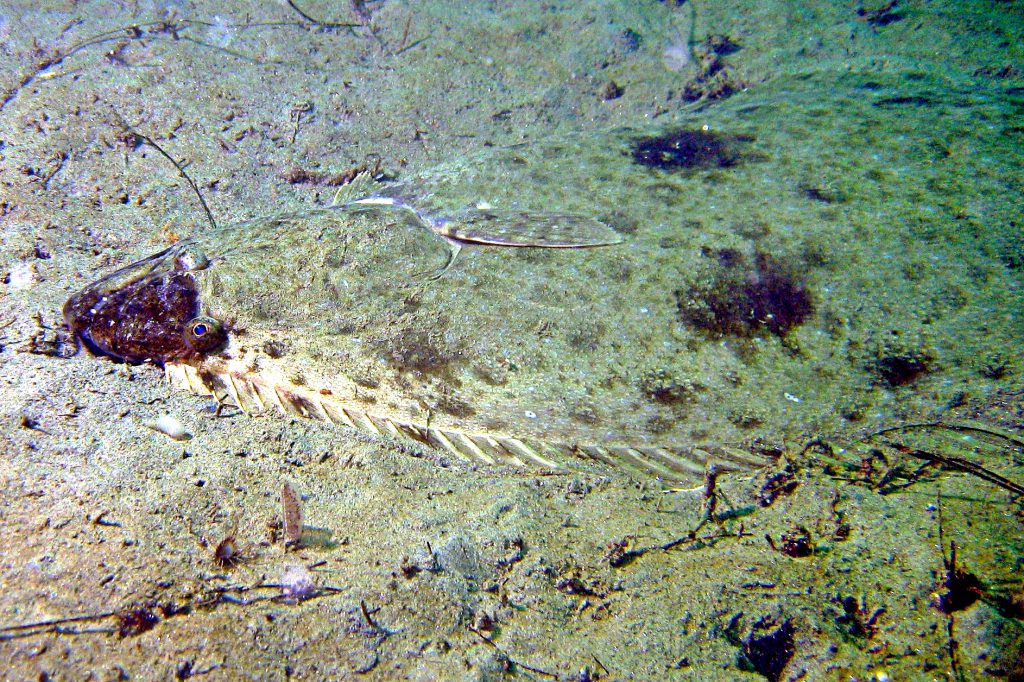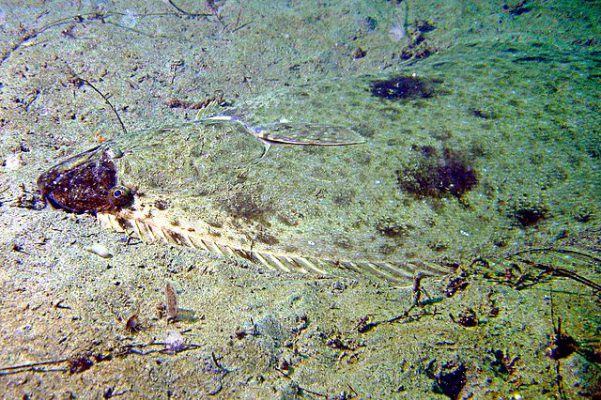How to Catch California Halibut

Growing up fishing in the coastal San Diego area, we targeted many different species. None were a more valued catch than halibut. Its strange beauty, powerful muscles, and desirable fillets entice many fishermen into learning how to catch California halibut.
Can you find the halibut in this picture?
There are good reasons why anglers love catching halibut. There are as many reasons why they can be so hard to catch. With the right setup and proper technique, an angler stands a much better shot at hooking and landing these fish.

Knowing how to catch California halibut takes a little research. Let’s better understand the fish!
Qualities of California Halibut
-Halibut are predators
Halibut are flat fish that camouflage themselves on the bottom. As they grow, they develop both eyes on the top half of their body. This gives them the vision they need to ambush unwary fish.
-Halibut have razor teeth and hard mouths
The razor-sharp teeth of a halibut are designed to provide lethal bites to prey. They must be handled with care when caught. A halibut’s mouth is full of bone structure making a good hook set more difficult.
-Halibut are strong
Once a halibut reaches adulthood, you’d better be ready for a fight. Halibut are known for long runs, and strong head shakes.
-Halibut thump the bait
While halibut can be known to have an aggressive strike, the opposite is often true. They are known to thump a bait once and sit.

One of my favorite ways to catch halibut is to fish saltwater lagoons.
Lagoon rigs
-Use an inland coastal rod
Rods for lagoon use don’t need to be as beefy as offshore models. Pick a rod with medium to fast action, and length for casting.
-Use a baitcasting reel
A spinning reel will work, but a baitcaster will offer better fighting control. Especially when jigging.
-Don’t skimp on line weight
Resist the temptation to fish lighter line trying to get more bites. You’ll be sorry when the one you wanted finally hits! I use monofilament at a minumum of 15 lbs. Spectra will work as well.
-Choice of jig matters!
Pick a jig you’re comfortable fishing of course. I do suggest single tail grubs in orange or white colors. Other variations will work. I typically use fish traps (rubber fish) with a 3/8 ounce lead head (weight with hook built in).
We began by learning a few things about California halibut. This info will help us develop our technique.

Another Fine California Halibut Specimen. Notice The Continuous Curve Versus The Diamond Shape Of The Pacific Halibut.
Halibut jigging techniques
-Cast everywhere
The point is, don’t keep casting to the same spot. Don’t cast to obvious traps like weeds or high rocks. Do cast everywhere you can.
-Learn the bottom
Cast and let your jig sink to the bottom. Occasionally a fish will bite as it drops so be ready. Bring the jig up off the bottom by raising the rod tip. Let the jig sink again and repeat. Try varying speeds.
-Remember the thump
Don’t be fooled by a soft bite. If you feel a thump, steadily increase your reel pace to set the hook.
-Play the fish

Any halibut of decent size stands a good chance of getting free. Playing the fish will minimize this so go with the fish. Walk the way its going if you can and set your drag semi tight. Never let your line go slack and practice will make you better.
Enjoying fish caught by your own rod and reel rounds out the pleasure of fishing. Thank you readers! Help create this community! Share a story here. Give some knowledge. Ask any question. Send to…
Geoff@FISHTFIGHT.COM


Hi Geoff,
Very informative and eye-opening directory, I should say. From beginners’ guide to advanced angler, everything fish fighting related is there. California halibut is a really interesting part as well. I learned a lot. Your passion for fishing is impressive. To be honest, I have never gone fishing in my life, most probably because I was always under the impression that it was way too difficult. Now, seeing your website changed my perspective. I think it is not that difficult if you know the tricks. I think I should seriously consider trying it sometime soon. Thanks for the inspiration and good luck with your more exciting fishing adventures.
Baker Osman
Thanks for the comment Baker. Like a lot of things, fishing does take some practice. Knowing something about what you’re trying to do can make it much easier, and more fun. Going with someone who doesn’t mind teaching you is even better. Get a line out! Get a hook wet! Geoff.
Hi there,
I have never heard of a halibut but I live in Australia so you will have to forgive me LOL.To me it looks the same as our flounder, but It doesn’t get as big as your Halibut.
It’s funny I came across your site today as I just watching a fishing show this morning and one of the guy’s were saying that the flounder actually start off with eyes on opposite sides of the head and as the fish matures one of the eye’s moves to the other side.
Is it the same for the Halibut?
Great tips and site by the way!!
Regards
Joel
Hello Joel, and thanks for commenting. You are absolutely correct! Halibut, like flounder, start very young with eyes on opposite sides of their head. It doesn’t take long for the eyes to switch though. I’ve caught some 4-6 inch halibut, and the change had already occured. Geoff.
Great read, very informative and interesting. I sure do miss fishing that halibut in Carlsbad!
You know it Steve! Best but I caught was out of Agua Hedionda. 31 in fish. Heck of a fight on a $10.00 two piece Shakespeare rod, and a $30.00 Abu Garcia reel with a messed up drag. Lol. Geoff.
Nice work, Geoff!
Thanks Gail. I appreciate it.
Very interesting article i have never fished for halibut but you give great info as to how if you are wanting to learn and give it a try. I live in the Midwest and we do a lot of Bass and Crappie. I also like Catfish have only been fishing in the ocean once when i got married in Antigua. Caught a lot of Barracuda. Thanks for the good read.
My pleasure Shawn. You do some awesome fishing that I haven’t had the opportunity to try. I have fished bass and trout, especially in my younger years. I love fly fishing too. However, my love of the ocean and the powerful species of pelagics keep me going back. Thanks so much for commenting.
I’m headed to California this summer on vacation and a friend who lives there is taking me fishing so I’m glad I found your site.
Halibut is on of my favorite fish to eat but I’ve never had a chance to fish for them. I’m used to bass lakes or snapper in the Gulf of Mexico.
I’ve got your site bookmarked and hopefully this July I’ll have some halibut success!
Thanks for your article.
Hey I’m glad you found it helpful. This is one of many proven methods to catch these hidden predators. Good luck and better skill out there. Geoff.
Thanks for the tip that catching a Halibut will require a little bit of research. You also mentioned that Halibut are predatory fish. I think it’s a good idea to bring a couple of different types of lures with you on your trip in case other fish are biting.
Hi Cindy. Thanks for commenting. I always have different patterned lures when I fish. Sometimes the reason fish aren’t biting is that they’re not feeding on what you’re offering them. A change in size and color can be all it takes to start getting bites when you were getting none before.
You brought up a good point and I appreciate you mentioning it. Geoff.
Nice little article although basic. Make sure your source pictures are of the species your articles are about. Some of your pics are Pacific halibut found from Alaska to eureka and grow much bigger.
It would give you more validity.
Thanks for the feedback DJ. This was one of my very first articles and it is basic. But sometimes simple is sweet. I look back and cringe on old writing sometimes, but it does have a certain charm. Maybe it’s just me. You are correct about the discrepancy in Halibut species. I went in and added captions identifying Pacific versus California halibut. I think it’ll clear things up. Good points and thanks again for your time. Geoff.
One of my secret for halibut fishing is finding swallow to medium holes made by large ships anchoring (mark the spots) fishing them when the ships leave. The Halibuts get attracted to these holes for food or camouflage. You can also look for them with your depth finder, you’ll get the big halibuts if you can find these holes.
Hey Arnie thanks for the comment and the tip. That sounds like an effective technique for inshore style fishing. I’ve never heard of that before, but it makes real good sense. Geoff.
What do you do once you catch a halibut and bring it into the boat? I heard you need to cut some thing in its mouth.
I don’t recommend putting your hand anywhere near a halibut’s mouth, unless you’re wearing chain mail gloves.
I suppose some people may bleed halibut to preserve the meat. Personally, never had an issue with the bloodline ruining the white flesh. Best thing on a boat is to have a kill bag filled with ice. You can bleed a halibut first by clipping the gills near the bottom of the mouth. But be careful of those teeth.
If you’re on a sportfishing vessel, no need to worry at all. The crew should ensure the freshness of your catch.